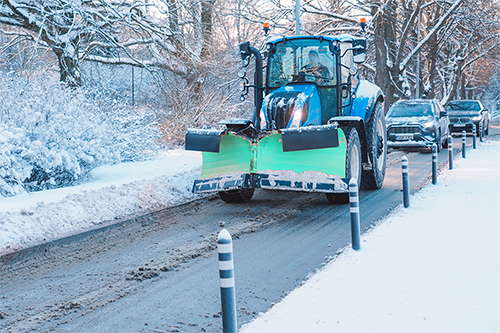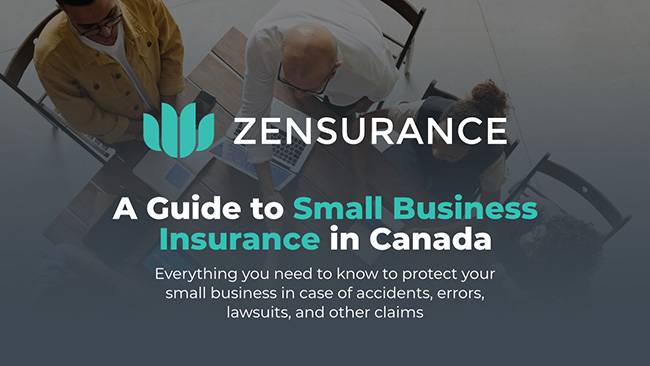It may be early August, but it won’t be long before the temperature drops and winter will be upon us.
The time to get ready for the wintry road ahead for snow removal contractors is now, including securing a comprehensive snow removal insurance policy.
However, getting the right coverage to protect your snow removal business and operations from its liabilities can be challenging. A recent Zensurance poll of Canadian small business owners found a combined 51.7% cited the cost of business insurance and getting insured as among their top concerns.
Let’s review what type of insurance snow removal professionals require, the steps they can take to reduce accidents and injuries, and ways to keep premiums low.

Download Our FREE Insurance Guide
Learn everything you need to protect your small business.
Whitepaper download
"*" indicates required fields
Your email address will be used by Zensurance to provide latest news, offers and tips.
You can unsubscribe at any time.

What Is Snow Removal Insurance?
Also called snowplow insurance or snow removal liability insurance, snow removal insurance is a policy designed to cover the liability and financial risks professional contractors and subcontractors face.
Most snow removal insurance policies contain several coverages to address those risks, including:
- General liability insurance covers third-party bodily injuries and third-party property damage caused by your operations.
- Commercial property insurance protects your business’s property, office, or warehouse and your business contents and inventory if damaged by fire, water, a natural disaster, theft, or vandalism.
- Commercial auto insurance covers damages to your vehicle, other vehicles, or injuries to people if you’re involved in a collision.
- Tools and equipment insurance repairs or replaces damaged or stolen transportable tools and equipment.
- Equipment breakdown insurance covers paying to repair internal damages to your equipment and computers caused by a mechanical or electrical malfunction.
- Business interruption insurance to cover your lost income and operational overhead if you’re forced to close temporarily following an insurable loss, such as a fire that damages your business property (note: you must have commercial property insurance to include business interruption insurance in your policy).
What Liability Risks Do Snow Removal Contractors Have?
Insurers consider snow removal services high-risk because of the many accidents, injuries, and property damages. Among the common risks snow removal professionals face are:
- Slip and fall accidents. Icy roads, parking lots, and walkways and heavy snowfall increase the likelihood of slip-and-fall accidents, injuring customers and other third parties.
- Property damage. Snow removal can inadvertently cause damage to third-party properties, such as driveways, landscaping, or vehicles.
- Equipment costs. Snow removal contractors require specialized equipment and vehicles, which can be costly to repair or replace.
- Geographical factors. The cost of snow removal insurance varies based on your location. Areas with heavy snowfall and frequent storms may have higher insurance costs due to increased risk.
10 Safety Tips for Snow Removal Contractors
Here are 10 recommended tips for safely providing snow removal services that contractors should consider:
1. Identify hazards
Identify and assess hazards on properties before beginning work. Take all possible steps to eliminate or minimize them.
2. Pile snow in safe locations
When melting occurs, large piles of snow can flood properties, create run-off problems, and re-freeze during freeze-thaw cycles. Choose areas to pile plowed snow where there is less of a chance of that occurring, and be careful not to pile snow in spots that restrict or obscure the view of motorists.
3. Do routine checks of snowplow equipment
Ensure your vehicle and snow removal equipment are in tip-top shape by regularly inspecting them and addressing any issues promptly. Inspect your vehicle and equipment before and after each shift, and have winter tires installed on vehicles from November to May.
4. Wear proper clothing and footwear
Dress in layers and wear quality footwear and high visibility safety clothing when working in high-traffic areas and early mornings, evenings, and at night.
5. Don’t work while fatigued
Working while tired leads to making mistakes and potentially causing accidents and injuries. Ensure you’re fully rested before beginning work.
6. Follow the rules of the road
When clearing parking lots, streets, roads or highways, always drive defensively and follow the rules of the road. Avoid being a distracted driver when behind the wheel.
7. Use the lift-shove technique
When using a hand shovel, bend at the knees and not the back when lifting piles of snow. Push snow away instead of lifting it if possible. Avoid overloading your shovel and lighten the load to avoid straining your body. Also, don’t throw snow over your shoulder or twist with a shovelful of heavy snow to prevent injuries.
8. Be cautious when using snow blowers
When using a snow blower, follow the manufacturer’s instructions for maintenance and usage. Be careful where snow is directed to avoid damaging your customer’s or a third party’s property.
9. Ensure all subcontractors have insurance
If you hire subcontractors during the winter to represent your business, do thorough background checks on each subcontractor and require them to provide you with a valid certificate of insurance you can use to verify they are insured.
10. Take preventative action to minimize ice forming
Apply road salt or ice melt before and after snowfalls to reduce the chance of ice forming on customer properties, especially on walkways and stairs.
How to Keep Your Snow Removal Insurance Premium Low
With more frequent and costly liability claims and lawsuits associated with snow removal services in recent years, there’s been a significant increase in premiums to cover those claims.
The Insurance Bureau of Canada estimates commercial liability coverage claims that include slip-and-fall incidents on icy surfaces increased by 108% between 2013 and 2020, rising from $2.4 billion to $5.1 billion.
While that may be out of your control, there are things you can do to keep your annual premium as low as possible, including:
- If you provide different services during the warmer months, such as landscaping, buy snow removal liability coverage annually as part of your overall policy.
- If you are buying seasonal snow removal insurance, fill out an application for a free quote and buy it before autumn. Insurers tend to have limited capacity for offering snow removal insurance due to its high-risk nature, so getting covered as soon as possible is recommended.
- Ensure you and any employees who drive snowplow vehicles are experienced, trained, and have clean driving records and insurance claim histories.
- Always accurately document and maintain records of your work on customer properties. Include before and after photos, the time and date when you applied your services, record weather conditions, and any incidents that occur while on site.
- Create and maintain an accurate inventory of your business contents, equipment, raw materials, and their values.
- Have a risk management and business continuity plan that includes regular safety and equipment inspections, emergency response procedures, and employee training. Ensure all employees know about that plan and have access to it.
- Have a lawyer draft and review customer contracts and liability waivers that detail your scope of work and responsibilities to help prevent legal disputes from arising.
How to Get Low-Cost Snow Removal Insurance Fast
Zensurance is Canada’s leading small business insurance brokerage insuring thousands of small business owners and independent professionals across hundreds of industries, including snow removal contractors.
We can quickly help you get low-cost snow removal insurance coverage.
Fill out our online application for a free quote in less than five minutes.
Our knowledgeable brokers will shop our partner network of more than 50 insurers to find a policy that addresses your risks, customize it to suit your requirements, and send you your policy documents and a certificate of insurance.
– Updated August 14, 2024.
Recent Posts
Why November Is the Perfect Time for Bookkeepers to Review Their Insurance
As we inch toward the end of another year, bookkeepers are busy preparing for the end of their clients’ financial year. But now is the ideal time for bookkeepers to review and assess their insurance. We’ll give you 10 reasons why.
Is Your Salon Ready for the Holidays? Insurance Tips for Beauticians
Salon owners and independent beauticians need to stock up on the products they need to make their clients shine over the holidays. But ensuring they're adequately covered with customized insurance is also critical. Here's what to know.
10 Tips for Closing Your Small Business for the Winter
Are you closing up shop for the winter? Ensuring your property is prepared for winter and your valuable contents and inventory are safely stored is vital. See our tips for how small business owners can shut down operations and keep their assets safe.
Sign Up for ZenMail
"*" indicates required fields








